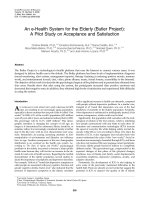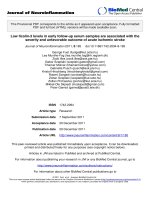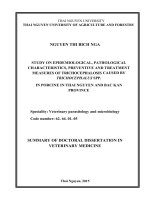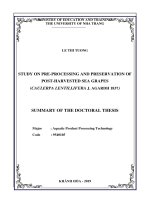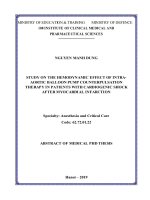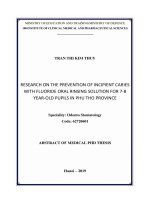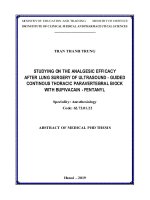The summary of medical phylosophic thesis: Study on clinical and subclinical characteristics, computed tomography imaging of acute ischemic stroke after revascularization within 6 first
Bạn đang xem bản rút gọn của tài liệu. Xem và tải ngay bản đầy đủ của tài liệu tại đây (617.43 KB, 24 trang )
MINISTRY OF EDUCATION AND TRAINING
MINISTRY OF DEFENCE
VIETNAM MILITARY MEDICAL ACADEMY
NGUYEN QUAN AN
STUDY ON CLINICAL AND SUBCLINICAL
CHARACTERISTICS, COMPUTED TOMOGRAPHY
IMAGING OF ACUTE ISCHEMIC STROKE AFTER
REVASCULARIZATION WITHIN 6 FIRST HOURS
Specialized: Neurology
Code: 9720159
THE SUMMARY OF MEDICAL PHYLOSOPHIC THESIS
Hanoi - 2020
THIS STUDY HAD BEEN COMPLETED IN VIETNAM MILITARY
MEDICAL ACADEMY
Supervisor:
1. PROF. PhD. NGUYỄN MINH HIỆN
Reviewer No. 1: PROF. PhD. Tran Van Tuan
Reviewer No. 2: PROF. PhD. Tran Cong Hoan
Reviewer No. 3: PROF. PhD. Nguyen Van Thong
The thesis was defended in the Committee Council of Vietnam
Military Medical Academy at ……………..
The PhD thesis can be found at:
1. National Library
2. Library of Vietnam Military Medical Academy
INTRODUCTION
According to the World Health Organization (WHO), stroke is the third leading cause of death and
leading cause of disability in adults, in which ischemic stroke accounts for about 80-85% of stroke patients.
The incidence of stroke ranges from 600-1430/100,000 people depending on the country. The current
guideline for stroke treatment is to treat early, positively, comprehensively and prevent recurrence based on
the degree of damage of brain parenchyma, collateral circulation, risk factors for each patients.
The brain is a high level nerve center, accounting for only 2% of the weight but requires a mass of
blood to 20% of the body's blood. The vascular system of the brain is very rich and, when forming the clots
it caused cerebral infarction, which is the cause of various neurological deficiencies. If the cerebral blood
flow (CBF) is 22ml/100g/minute, there will be a slight deficiency and complete paralysis when CBF is
8ml/100g/minute. On electroencephalography, the automatic reflex of the cortical cells will completely lose
at about 18ml/100g/minute.
The life time of a nerve cell can be extended when CBF from 17-20ml/100g brain/minute, if CBF is
12ml/100g/minute, the life time of brain cells can last for about 2-3 hours, then progress to true lesions,
when CBF ≤ 11ml/100g/min, brain cells die and do not recover. These characteristics depend on the time
from the onset to the time of treatment, which is the basis for the golden-time emergency treatments of "time
is brain" treatment techniques.
Over the past decade, in parallel with comprehensive treatment, the use of thrombolytic agents,
intervention to remove thrombosis, has brought many positive results in reducing mortality and disability for
stroke patients. Acute cerebral infarction.
The patients with cerebral infarction who had a resuscitation in the first 6 hours had risk factors (age,
blood pressure, cardiovascular history), clinical, subclinical features, brain imaging, bladder circulation ?
What is the relationship between these factors?
In fact, in hospital settings in Vietnam, during a stroke emergency, during the first hours, emergency
crews often focus on techniques to re-open circuits or ensure survival indicators without full attention to the
above factors so the treatment results are limited and vary.
In order to comprehensively assess risk factors, clinical and subclinical characteristics, brain CT images
of patients with cerebral infarction were re-opened in the first 6 hours to improve the effectiveness of
treatment at hospitals. To collect and treat strokes, we conduct research on the topic "Study of clinical
features, subclinical and computerized tomography images of patients with cerebral infarction in the first 6
hours" to 2 target:
1. Description of clinical, subclinical characteristics and images of ARVs in patients with cerebral
infarction are re-activated in the first 6 hours.
2. Analysis of the relationship between clinical features and images of cerebral infarction re-released in
the first 6 hours on CT scan images.
The structure of the thesis
The thesis consits of 120 pages, including: introduction 2 pages, the overview 32 pages, objects and
methos 13 pages, results 24 pages, discussion 34 pages, conclusion 2 pages, recommendation 1 page.
There are 32 tables, 01 grapth, 144 reference in which 23 Vietnamese and 121 English articles.
CHAPTER 1: OVERVIEW
1.1. Definition and classification of ischemic stroke subtypes
1.1.1.
Definition
Definition of ischemic stroke by World Health Organization 1989.
1.1.2.
Classification of ischemic subtypes
Classification of ischemic subtypes based on OCSPC 1991.
Sort NMN based on TOAST.
1.2. Blood supply to the brain
1.2.1. Arteries perfuse blood to the brain
1.2.1.1. Internal carotid arteries
1.2.1.2. Vertebrobasilar arteries
1.2.2. Brain blood flow
1.2.3. Factors affecting brain blood flow
Hypertension, Alteration of structures and function of brain arteries, brain arteries with a suitable structure.
1.2.4. Circulatory connection of cerebral arteries
1.2.4.1. Circulatory connection of internal carotid arteries and external carotid arteries
The connection of internal carotid arteries and the external carotid arteries via circulatory connection of the
central retina artery, maxillary artery.
Connection of the vertebral artery and external carotid artery via the occipital artery
Connection of the internal carotid artery and basilar artery, which allows transverse perfusion to the brain
hemisphere, the flow within Willis can supply blood to the blocked arteries.
1.2.4.2. The circulatory connection on the surface of the brain;
Between anterior cerebral artery - mid cerebral artery – posterior cerebral artery, between posterior cerebral
artery and cerebellum.
1.2.5. Levels of circulatory connection
- Characteristics of collateral circulation when cerebral embolism happens: The further the occlusion is from
the brain (near the aortic knuckle), the greater the ability to perfuse the brain.
The slower the embolism happens, the more effective the collateral circulation works.
1.3. Mechanism of brain anemia and progress over time
1.3.1. Blood flow and normal metabolism
Brain cells mainly depend on oxygen and glucose. The brain uses glucose as the only substance for energy
generation, and glucose is oxidized into carbon dioxide (CO2) and water. The metabolism of glucose results in
adenosine diphosphate (ADP) and then adenosine triphosphate (ATP). The presence of oxygen increases the brain's
efficiency in generating ATP.
1.3.2. Factors affecting the viability of brain cells
1.3.2.1. The impact of collateral circulation
1.3.2.2. Blood transport nutrient
1.3.2.3. Changes inside lesions of blocked blood vessel
1.3.2.4. Internal resistance of the peripheral vascular network
1.3.3. Penumbra
Some parts of the brain parenchyma are rapidly destroyed and unable to recover from ischemia, the enclosed
brain area is still able to survive for a few hours (the Penumbra area). The progression of mild neurological deficiency
when the cerebral blood flow (CBF) is 22ml/100g/minute and complete paralysis when CBF is 8ml/100g /minute or
under.
1.4. Clinical characteristics of stroke patients
The clinical characteristics of ischemic stroke patients depend on the location of the affected brain part.
1.4.1. Cerebral artery thrombosis
1.4.1.1. Common clinical characteristics
- Most patients have symptoms before the onset of ischemic stroke, this stage is very important for proper diagnosis of
cerebral artery thrombosis. The sign is warning TIA attacks. Depending on the location of the thrombosis, TIA can
cause different clinical symptoms.
- Stroke onset context: Stroke usually occurs at night or early in the morning
- Stroke onset: Most patients start with common symptoms of brain lesions (fatigue, dizziness, numbness in the limbs,
etc) before the stroke onset from a few hours to a few days.
- Process pattern: patients often describe gradually or rapidly progressive clinical symptoms.
- Common neurological symptoms: headache, vomiting, convulsions, mild conciousness disorders, possible sphincter
disorders, frequent urinary retention or urinary incontinence.
- Localized neurological symptoms: Depending on the artery lesion, there are corresponding clinical symptoms: Speech
disorders, seventh cranial nerve paralysis and hemiplegia on the side of the body opposite to the area of cerebral
damage, cerebral palsy, brain stem and/or medulla damage (HC Weber, Benedickt, Foville, Milard - Gubler).
1.4.2. The cerebral artery syndrome
- Internal carotid artery occlusion syndrome
- Mid cerebral artery syndrome
- Vertebrobasilar Insufficiency syndrome
1.5. Visual characteristics of cranial CT Scan in stroke patients within 6 hours after stroke onset
1.5.1. Computed tomography without contrast
1.5.1.1. Signs for early diagnosis of ischemic stroke
Cranial CT scan allows early diagnosis of ischemic stroke, but does not give an accurate measurement of the
volume of anemia, does not assess the vascular condition, does not assess the survival possibility of brain parenchyma,
especially in the early stage. Five basic signs to early diagnose ischemic stroke on CT scan without contrast:
hyperdensity of artery, hypodensity of brain parenchyma, hypodensity of lentiform nucleus, loss of insular ribbon,
losing the distinction between gray matter and white matter, and unclear brain grooves.
1.5.1.2. ASPECT scale
ASPECT scale has been widely used since 2000 in clinical practice to assess the degree of early ischemic
changes on brain imaging. The ASPECT scale is a 10-point scoring system that is equivalent to 10 anatomical regions
according to the blood supply region from the mid cerebral artery.
1.5.2. Computed tomography with contrast
1.5.2.1. Position the blocked artery
1.5.2.2. Assess brain parenchyma from scanned image
1.5.2.3. Assess the degree of collateral circulation
1.6. Thrombectomy and thrombolysis treatment in ischemic stroke patients
1.6.1. Thrombolysis
1.6.2. Thrombectomy
CHAPTER 2
OBJECTS AND METHODS OF THE STUDY
2.1. Studied objects
2.1.1. Object, time, and place of study
From June 2016 to July 2017, we conducted a study of 114 patients with acute cerebral ischemic stroke at
Stroke Center, 108 Military Central Hospital. These patients were selected under the selection and exclusion criteria.
2.1.2. Selection criteria
- The patient is diagnosed with acute ischemic stroke within the first 6 hours after the stroke onset to admission at 108
Military Central Hospital; Based on Guidelines for the Early Management of Patients With Acute Ischemic Stroke in
2015 by American Heart Association/American Stroke Association (AHA / ASA)
+ Clinical symptoms: face dropping, sudden weakness of the body, sudden trouble speaking, turning head and eyes
towards the intact side.
+ Patient have:
- CT scan without contrast to exclude hemorrhagic stroke.
- CT scan with contrast to identify damaged brain artery. Classify subtypes of stroke: blocked large arteries or small
artery (lacunar infarct) . Identify the infarction happens on the anterior cerebral circulation or the posterior cerebral
circulation.
+ If the patient has a history of brain stroke, mRS score exclude from 0 to 1 score
+ ≥ 18 years of age
+ Less than 6 hours after the stroke onset
+ patient or his/her legal protector approved to participate in the study.
+ Patients have been under treatment: thrombolysis, thrombonectomy or a combination of the two above treatments.
2.1.3. Exclusion criteria
- Hemorrhagic stroke
- Ichemic stroke patients with a history of traumatic brain injury, encephalitis, and/or brain tumor.
2.2. Research Methods
2.2.1. Study design
A prospective descriptive and cross-section study.
2.2.2. Clinical study
2.2.2.1 Questionaire
* Create a unified registration form based on such criteria as: Age, gender, time of onset, nature of the onset, place of
the onset, time of admission to Emergency Department.
* Identify stroke signs of the patient: Sudden face dropping, numbness or weakness of one arm and/or one leg on one
side of the body, difficulty speaking or communicating, sudden loss of vision in one or both two eyes, dizziness, loss of
balance or movement coordination disorders.
* Identify the time of stroke onset.
* Collect patient's medical history and information.
2.2.2.2. Clinical examination
- Access neurological symptoms (hemiplegia, cranial nerve palsy, sensory disorders, speech and language disorders,
etc.), consciousness disorders, vital signs such as pulse, blood pressure, heart rate, breathing, SpO2, temperature.
- Access patients’ situation based on: Glasgow, limb muscle strength MRC, NIHSS.
2.2.3. Subclinical study
- Blood count, blood biochemistry, immunity, ECG, cardiac ultrasound.
- CT scan of cranial brain imaging, Computed tomography angiography (CTA), right at the Emergency Department.
- Digital Subtraction Angiography (DSA) to prepare for cerebral intervention.
- Evaluate ASPECT scores, consider early signs on cranial CT, collateral circulation scale, occlusion location.
2.3. Study content
2.3.1. Describe the clinical features, CT images of brain in patients with ischemic stroke and recirculation done in 6
hours.
2.3.1.1. Common characteristicsof the studied objects
- Identify age, gender, risk factors, time of stroke onset
2.3.1.2. Clinical and subclinical characteristics
- Stroke onset symptoms, physical signs upon admission, blood count, biochemistry, echocardiogram,
Electrocardiography - ECG, cranial CT scan, assess patients with ASPECT, pc-ASPECT score on cranial CT film.
+ Identify brain lesions on CT angiogram: lesion area, damaged artery location, assess the degree of collateral
circulation.
2.3.2. Evaluate the relationship of clinical signs with CT images in ischemic patients who had recirculation in the
first 6 hours
- Assess the relationship between early signs on cranial CT scan according to time: less than 3 hours, 3 to 4,5 hours and
from 4.5 to 6 hours.
- Assess the relationship between clinical characteristics of patients with hypodensity of brain parenchyma and patients
without hypodensity of brain parenchyma on CT scan film.
- Assess the relationship between clinical features of patients with cerebral infarction due to damages on the anterior
cerebral circulation and damages on the posterior cerebral circulation.
- Assess the relationship between clinical characteristics of patients with ischemic stroke to ASPECT score.
- Assess the relationship between the NIHSS score and the ASPECT score.
- Assess the relationship between the limb muscle strength and the ASPECT score.
- Assess the relationship between the NIHSS score and the collateral circulatory system score of the anterior cerebral
circulation system.
- Assess the relationship between Glasgow point and the collateral circulatory system score of the anterior cerebral
circulation system.
- Assess the relationship between the limb muscle strength and the collateral circulatory system score of the anterior
cerebral circulation system.
2.4. Data processing methods
- Data collection and data input using SPSS 22.0 software.
2.5. Research ethics
- Ensuring medical ethics during the study.
CHAPTER 3 : RESULTS
3.2. Clinical features and CT scan images of acute ischemic stroke in the first 6 hours
3.2.1. Characteristics of clinical symptoms of patients at hospitalized time
Table 3.4. Clinical signs at hospitalized time
No.
1
2
3
4
5
6
7
8
Onset symptoms
Language disorder
Hemiplegia
Face dropping
Headache
Sensation disorders on one side of the body
Dizziness
Vomitting
Convulsion
Number of patients
(n=114)
104
110
105
31
20
15
10
1
Ratio (%)
91,2
96,5
92,1
27,2
17,5
13,2
8,8
0,9
Table 3.5. Glasgow at hospitalized time
Number of patients
(n = 114)
Ratio
(%)
15
29
25,4
9-14
71
62,3
6-8
12
10,5
3-5
2
1,8
Group
Glasgow Scale
Average Glasgow Scale: 11,98 ± 2,65
- Average Glasgow Scale of Stroke Patients was 11,98 ± 2,65.
Table 3.6. Classification of muscle scaleat hospitalized time
Group
Upper limb muscle
Lower limb muscle strength
strength
Muscle Scale- MRC
n = 114 (%)
n = 114 (%)
0
1
2
3
4
5
66 (57,9)
61 (53,5)
16 (14,0)
19 (16,7)
8 (7,0)
10 (8,8)
20 (17,5)
19 (16,7)
2 (1,8)
2 (2,6)
2 (1,8)
2 (1,8)
Table 3.7. NIHSS scoreat hospitalized time
Number of patients
Ratio
(n = 114)
(%)
≤5
9
7,9
6 – 15
38
33,3
16 – 20
30
26,3
21 – 42
37
32,5
NIHSS score group
NIHSS group
Average
16,897,14
The average NIHSS score of patients in this study was 16.897.14 scores, the highest was 42 scores, the
lowest was 2 scores.
Table 3.8. Characteristics of blood pressure at hospitalized time
Group
Number of patients
(n = 114)
Blood pressure
Systole
(mmHg)
Diastole
(mmHg)
Systolic HA group
(mmHg)
Average
140,61 25,58
Lowest
85
Highest
217
Average
81,80 14,10
Lowest
48
Highest
140
< 90
1 (0,9)
90 – 139
59 (51,8)
140 – 184
49 (43,0)
≥ 185
5 (4,4)
3.2.2. Hematological, biochemical, ultrasound and ECG characteristics of hospitalized patients
Table 3.9. The composition of complete blood count
General Group
(n = 114)
Complete blood
Counts
Red blood cell (T/l)
4,57 ± 0,55
Hematocrit (l/l)
0,41 ± 0,04
Platelets (G/l)
242,79 ± 76,73
Table 3.10. The basic coagulation components
No.
Coagulation components
Test result
1
Prothrombin time (s) (n = 102)
11,98 ± 3,73
2
INR (n = 54)
1,11 ± 0,31
3
Fibrinogen concentration (g/l) (n = 93)
4,00 ± 1,25
Table 3.11. The basic biochemical components
No.
Biochemical components
Test result
1
Cholesterol (mmol/L) (n=86)
4,93 ± 1,20
2
Triglycerid (mmol/L) (n=86)
2,05 ± 1,60
3
Blood Glucose (mmol/L) (n=110)
8,03 ± 3,02
Table 3.12. ECG characteristics
No.
Characteristics
1
Atrial Fibrillation
2
No atrial fibrillation
Number of patients
(n=99)
40
Ratio
(%)
35,1
59
51,8
Table 3.13. Doppler echocardiogram results
No.
Echocardiogramcharacteristics
Number of patients
(n=83)
Ratio
(%)
1
Normal
45
54,2
2
Heart failure
6
7,2
3
Mitral stenosis
18
21,7
4
Leaky heart valve
14
16,9
3.2.3. CT scan images features at hospitalized time
Table 3.14. Features of early brain damage on CT scan of the anteriorcerebral circulation
Group
Anteriorcerebral circulation
Signs
n = 104 (%)
Hypodensity ofthe cortex
57 (54,8)
Unclear brain grooves
35 (33,7)
Loss of insular ribbon
36 (34,6)
Unclear lentiform nucleus
21 (20,2)
Area of hypodensity >1/3
9 (8,7)
Signs of “Hyperdensity of artery”
12(11,5)
Most stroke patients come early with images of hypodensity ofthe cortex (54.8%). Early signs of damage were
noted as unclear brain grooves (33.7%).
Table 3.15. Characteristics of artery lesion sites
Characteristics of injury
Number of patient
Ratio
(n=114)
(%)
Internal carotid artery
40
35,1
Middle cerebral artery
61
53,5
Anterior cerebral artery
1
0,9
Vertebral artery
4
3,5
Basilar artery
6
5,3
Small cerebral artery
2
1,8
Table 3.16. ASPECT score for the blood supply area of the middle cerebral artery
Number of patients
(n=61)
Ratio (%)
≤5
2
3,3
6–7
14
23,0
≥8
45
73,8
ASPECT score
ASPECT group
Average: 8,30 ± 1,52
Table 3.17. Collateral circulation score of the anteriorcerebral circulation
Level of
Number
collateral
Ratio (%)
(n=102)
circulation
Good
24
23,5
Average
48
47,0
Bad
30
29,5
3.3. Relationship betweencranial CT scan and clinical features of patients with acute ischemic strokein
the first 6 hours
3.3.1. Relationship with onset time
Table 3.21. Relationship with onset time of stroke
< 3 hours
n (%)
3 - 4,5 hours
n (%)
>4,5 - 6 hours
n (%)
p
24 (54,5)
21 (48,8)
10 (37,0)
>0,05
20 (45,5)
22 (51,2)
17 (63,0)
>0,05
44 (100)
43 (100)
27 (100)
-
( X SD) (n = 61)
25 (8,68 1,31)
26 (8,12 1,37)
10 (7,80 2,20)
< 0,05
Anterior cerebral circulation
(n=104)
39 (88,6)
41 (95,3)
24 (88,9)
Posteriorcerebral circulation (n=10)
5 (11,4)
2 (4,7)
3 (11,1)
CT scan images
No hypodensity
(n=55)
Hypodensity
(n = 59)
Total (n=114)
ASPECT score
>0,05
>0,05
The ASPECT score of patients with ischemic stroke had a tendency to decrease over time from the
stroke onset to admission time, the difference was statistically significant.
Table 3.22. Relationship between early signs on cranial CT scan and time of stroke onset
14 (32,6)
>4,5 – 6
hours
n = 27 (%)
12 (44,4)
>0,05
8 (18,2)
18 (41,9)
10 (37,0)
<0,05
Unclear lentiform nucleus
(n=21)
4 (9,1)
8 (18,6)
9 (33,3)
<0,05
Area of hypodensity
>1/3(n = 9)
2 (4,5)
3 (7,0)
4 (14,8)
>0,05
Signs of “Hyperdensity of
artery” (n=12)
5 (11,4)
5 (11,6)
2 (7,4)
>0,05
The image of cranial CT
scan
< 3 hours
n =44(%)
3 - 4,5 hours
n = 43 (%)
Unclearbrain grooves (n=36)
10 (22,7)
Loss of insular ribbon(n=36)
p
The image of loss of insular ribbon and unclear lentiform nucleushas a significant relationship with the time
from the onset of brain stroke.
3.3.2. Relationship withhypodensity of brain parenchyma
Table 3.23. The relationship between clinical symptoms and the density of brain parenchyma
Group
n = 59 (%)
No
hypodensity
n = 55 (%)
p
31 (27,2)
15 (25,4)
16 (29,1)
> 0,05
10 (8,8)
3 (5,1)
7 (12,7)
> 0,05
Dizziness
15 (13,2)
5 (8,5)
10 (18,2)
> 0,05
Turning of head and eyes
towards the intact side
11 (9,6)
9 (15,3)
2 (3,6)
< 0,05
Sensation disorders on one
side of the body
20 (17,5)
7 (11,9)
13 (23,6)
> 0,05
Hemiplegia
110 (96,5)
58 (98,3)
52 (94,5)
> 0,05
Central seventh nerve
palsy
105 (92,1)
56 (94,9)
49 (89,1)
> 0,05
Language disorders
104 (91,2)
56 (94,9)
48 (87,3)
> 0,05
Sensory disorders
85 (74,6)
47 (79,7)
38 (69,1)
>0,05
General
n = 114 (%)
Hypodensity
Headache
Vomitting
Signs
3.3.3. Relationship with ASPECT score
Table 3.24. The relationship between clinical symptoms and ASPECT score
ASPECT
score
≤5
n = 2 (%)
6-7
n = 14 (%)
≥8
n = 45 (%)
p
Headache
1 (50,0)
2 (14,3)
14 (31,1)
> 0,05
Vomitting
0 (0)
1 (7,1)
7 (15,6)
> 0,05
Dizziness
0 (0)
1 (7,1)
7 (15,6)
> 0,05
Turning of head and eyes
towards the intact side
1 (50,0)
2 (14,3)
3 (6,7)
> 0,05
Sensation disorders on one
side of the body
0 (0)
2 (14,3)
13 (28,9)
> 0,05
Hemiplegia
2 (100)
14 (100)
45 (100)
< 0,01
Central seventh nerve
palsy
1 (50,0)
14 (100)
43 (95,6)
< 0,05
Language disorders
2 (100)
14 (100)
40 (88,9)
> 0,05
Sensory disorders
2 (100)
12 (85,7)
30 (66,7)
>0,05
Signs
Table 3.25. The relationship between NIHSS score and ASPECT score (n=61)
ASPECT
≤5
n = 2 (%)
6-7
n = 14 (%)
≥8
n = 45 (%)
≤ 5 (n=2)
0 (0)
1 (7,1)
1 (2,2)
6 – 15(n=28)
0 (0)
2 (14,3)
26 (57,8)
16 – 20(n=14)
0 (0)
6 (42,9)
8 (17,8)
21 – 42(n=17)
2 (100)
5 (35,7)
10 (22,2)
22,0 1,41
18,93 6,25
15,07 5,82
score
p
NIHSSscore
NIHSS
Group
<0,05
Average
<0,05
3.3.4. The relationship with collateral circulation score
Table 3.27. The relationship between NIHSS and collateral circulation score(n=102)
Collateral
circulation
NIHSS
Good
(n=24)
Average
(n=48)
Bad
(n=30)
p
≤ 5 (n=6)
4 (16,7)
2 (4,2)
0 (0)
-
6-15 (n=36)
14 (58,3)
15 (31,3)
7 (23,3)
<0,05
16-20 (n=27)
4 (16,7)
13 (27,1)
10 (33,3)
<0,05
21-42 (n=33)
2 (8,3)
18 (37,5)
13 (43,3)
<0,05
Tabel 3.28. The relationship between Glasgow and Collateralcirculationscore (n=102)
Collateral
Good
Average
Bad
circulation
(n=24)
(n=48)
(n=30)
p
Glasgow
15 (n=25)
9-14 (n=66)
6-8 (n=10)
3-5 (n=1)
12 (50,0)
11 (45,8)
9 (18,8)
4 (13,3)
<0,05
34 (70,8)
21 (70,0)
1 (4,2)
0 (0)
4 (8,3)
1 (2,1)
5 (16,7)
0 (0)
<0,05
<0,05
-
Table 3.29. Relationship between limb muscle strengthand collateral circulation
Collateral
circulation
Muscle
ScaleMRC
Good
Average
Bad
(n=24)
(n=48)
(n=30)
p
Upper limb
0 (n = 63)
8 (33,3)
31 (64,6)
24 (80,0)
< 0,05
muscle
1 (n = 13)
2 (8,3)
7 (14,6)
4 (13,3)
< 0,05
strength
2 (n = 7)
4 (16,7)
1 (2,1)
2 (6,7)
< 0,05
3 (n=17)
8 (33,3)
9 (18,8)
0 (0)
< 0,05
4 (n=2)
2 (8,3)
0 (0)
0 (0)
-
5 (n =0)
0 (0)
0 (0)
0 (0)
-
0 (n = 58)
8 (36,0)
29 (60,4)
21 (70,0)
< 0,05
1 (n = 16)
2 (8,3)
8 (16,7)
6 (20,0)
< 0,05
2 (n = 8)
3 (12,5)
2 (4,2)
3 (10,0)
< 0,05
3 (n=17)
9 (37,5)
8 (16,7)
0 (0)
< 0,05
4 (n=3)
2 (8,3)
1 (2,1)
0 (0)
-
5 (n =0)
0 (0)
0 (0)
0 (0)
-
Lower limb
muscle
strength
1
CHAPTER 4: DISCUSSION
4.2. Clinical features and CT scan of the skull in patients with acute
cerebral infarction within the first 6 hours
4.2.1. Characteristics of clinical symptoms when patients are hospitalized
Survey of common clinical symptoms in patients with acute
ischemic stroke in the first 6 hours shows that most patients with
hemiplegia accounts for 96.5%, ;palsy of the central seventh nerve when
hospitalized is 92.1%, language disorder is 91.2%, consciousness
disorder from drowsiness and coma is 74.6%.
Symptoms of hemiplegia
Similar to the research results of Do Duc Thuan et al. (2017):
Hemipleigia in patients with acute ischemicstroke who came earlyare
treated by thrombolytics accounting for 79.24% [75], followed by
language disorder 75.47% and consciousness disorder 35.85%. Thus,
classic symptoms such as hemiplegia and language disorders are noted.
At higher rates than other symptoms, these are easily recognizable
symptoms and highly specific for ischemic stroke.
Symptoms of language disorders
In our study, the common language disorder is difficulty speaking,
lisp, speech loss that appear immediately after the patients have had cerebral
infarction, which accounts for 91.2%. Other studies also show that a high
proportion of patients with cerebral infarction in the first 6 hours have
language disorders.
Glasgow coma scale upon hospital admissions
Glasgow coma scale is a quantitative scale to assess a patient's
consciousness. The scoring scale has three factors: eye opening response,
verbal and motor response. The lowest total GCS score is 3 points (deep
2
coma) and the highest one is 15 points (absolute consciousness). In this
study, we found that 62.3% of patients have GCS score from 9-14, the
number of patients with a Glasgow score below 8 points accounted for
12.3%. There was a significant proportion (25.4%) of conscious patients.
All research objects had an average GCS score of 11.98 ± 2.65.
Classification of muscle strength upon admissions
Basing on the muscle strength grading upon admission, they can
prognosis the levels of patients’ cerebral infarction well. In our study, a
large proportion of patients were hospitalized with complete paralysis of
hands (57.9%) and legs (53.5%). The result corresponds to the author
Nguyen Van Phuong’sresearch of 103 cases of large vessel occlusion reopened by mechanical devices, in which the percentage of patients with
complete paralysis of hands and feet when hospitalized were 52% and 46%
respectively.
General nerve damage on the NIHSS scale
The average NIHSS score of patients in this study was 16.89 ± 6.91
points (the highest was 42 points, the lowest was 2 points), most patients
have NIHSS score ≥6 points (93.3%). The proportion of patients with an
NIHSS score below 6 accounts is small approx. 6.7%. Studies by Do Duc
Thuan, Pham Dinh Dai and Dang Minh Duc (2017) at Military Hospital 103
[75], Sarver J.L (2012) [88] all recorded an average NIHSS score of 17
points. In our results, the patients with basilar artery occlusion went into
deep coma upon admission, among them, the highest NIHSS score recorded
was 42 points.
4.2.3. CT scans of patients hospitalized
Most stroke patients with early-stage cerebral stroke usually show
no obvious damage on CT scans, and at a certain point, it is not until the
lesions of hypodensity corresponds to the controlling cerebral artery area
3
become apparent that the signs become obvious. However, there are early
signs that help clinicians detect lesions of cerebral infarction on CT scans.
Other studies also noted that the sensitivity on without-contrast CT scans
ranges from 40-73% for patients with cerebral infarction in the first 6 hours.
Thus, many studies have recorded a significant proportion of images of
early parenchymal injury in computerized tomography.
Characteristics of location of artery lesion
Regarding to the location of embolization in the study, we mainly
see patients with acute cerebral infarction in the anterior cerebral artery
system, the majority of which was in mid cerebral artery (53.5%) and
internal carotid artery (35.1%). The posterior arterial system including
basilar artery, vertebral artery and posterior artery accounts for negligible
proportion. Therefore, in this study, we observed that patients with
occlusion of major branch were mostly recanalized with mechanical
devices.
ASPECT
The ASPECT was only calculated for patients with acute anemia in
the mid-arterial blood supply region, including 61 patients. In the first 6
hours, only 2 patients had the ASPECT below 5 points, accounting for
3.3%. Most patients have an ASPECT above 6. This rate is quite similar to
the previous study of Nguyen Hoang Ngoc et al at Central Military Hospital
108. The ASPECT that systematizes the early signs on CT scan of brain are
applied to diagnosis and prognosis for patients by the authors in the world.
The score has 10 points that are equivalent to 10 anatomic regions according
to the blood supply region of the middle cerebral artery, i.e. for each
location of lesion, one point will be subtracted , ASPECT ≥ 8 is a good
prognosis, ASPECT score ≤ 5 is severe prognosis.
4
The characteristics of collateral circulation for the blood supply area of
the anterior cerebralcirculation system
Regarding the collateral circulation point on vascular CT scan, the
system of application points of the Albecta Academy of Canada is quite
easy when done directly on the computer with 3-stroke scanning. Assessing
the collateral circulation on CTA images in stroke patients in the first 6
hours is a relatively new idea compared to the reports in Vietnam. Many
researches in the world confirm that evaluating collateral circulation is the
best way to select patients for intervention for mechanical thromboembolism
such as IMS III. Our results show that the majority of patients with
moderate collateral circulation score accounted for 47.0%. Only 23.5% of
patients had good collateral circulation points.
4.3. Relationship between CT scan of brain and clinical features of
patients with acute cerebral stroke within the first 6 hours
4.3.1. Relationship with prodromal period
The period from prodromal period to admission is an important
factor; therefore, we evaluate whether different periods relates to the lesions
showned on cranial CT scan or not? Our chosen time frames are less than 3
hours, from 3 to 4.5 hours and more than 4.5 to 6 hours. These are important
period of time in making decisions on either the treatment of fibrinolysis or
mechanical interventions. Our results show that the ASPECT of patients
with brain stroke tends to decrease over time from prodromal period to
hospitalization, the difference is statistically significant with p <0.05.
4.3.2. Relationship with hypodensity of brain parenchyma density
We tried to find out if there was any difference in clinical signs in
patients with and without lesions on brain CT. In fact, these also right the
patient coming sooner or later but we did not find such really strong
relationships that we were able to make special comments about them. The
5
analysis results showed that patients with a reduction in the brain
parenchyma density in CT scans had more obvious symptoms of eye
turning, head turning, the difference was statistically significant for eye
rotation, head rotation (p < 0.05).
4.3.3. Relationship with ASPECT
Relationship between clinical symptoms and ASPECT
When analyzing the relationship with clinical manifestations, we
found a significant relationship between symptoms of palsy of the central
seventhnerve and hemiplegia symptoms with ASPECT (p <0.05; p < 0.01).
When examining patients who took blood clots by mechanical devices, the
author found that patients with ASPECT from 5 to 10 points were more
benefited from brain intervention than those with low ASPECT.
Relationship between NIHSS score and ASPECT score
The average score of NIHSS in patients with ASPECT ≤ 5 was
22.0 1.41, which was significantly higher than the other two groups. A
higher NIHSS score is more common in patients with lower ASPECT. This
clearly shows the relationship between clinical status and severity of
cerebral infarction through imaging survey. This will help clinicians more
easily predict when the method of recanalisation are used. A number of
studies around the world have mentioned this problem such as Kent DM’s
(2005).
4.3.3. Relationship with collateral circulation point
The relationship between NIHSS and collateral circulation
We compared the collateral circulation with the NIHSS clinical
scale at the time of admission, the results showed that there was a
statistically significant relationship between the collateral circulation and
NIHSS score. For patients with good collateral circulation, the ratio between
2 groups of NIHSS ≤ 15 and NIHSS> 15 are 75%, 25%, respectively. The
6
rate for the group with bad collateral circulation was 23.3%; 76.7%. The
results are similar to Nambiar's study [84] with significant relationship
between the two groups with p <0.01.
Relationship between GCS and collateral circulation
For groups of GCS of 15, the number of patients has a decreasing
rate from good to bad collateral circulation are: 50%; 18.8%; 13.3%, in
contrast to that one ofGCS ≤ 8, the number of patients had an increasing
parenchyma densityfrom good to bad are: 4.2%; 10.4%; 16.7%. The study
has shown a significant relationship between GCS and collateral circulation
with P <0.05. A number of studies in the world have shown a close
relationship between the assessment of OI score on CT images, the status of
consciousness disorder and neurological outcomes after 90 days. Basing on
this relation, when conducting intervention for recanalisation, they possibly
predict the outcome of the treatment for patients after 90 days.
Relationship between hand and leg strength and collateral circulation
When comparing the correlation between collateral circulation and
other clinical scale of arm and leg strength, the results showed a significant
correlation. Evaluation of muscular strength is both significant in the diagnosis
and it helps clinicians predict patients, especially patients who are recanalized.
Our finding of the relationship between muscle strength and collateral
circulation on CT scans in patients with acute cerebral infarction in the first 6
hours will help clinicians prognosis the effectiveness of treatment with
techniques of Recanalisation.
7
CONCLUSION
1. Description of clinical, subclinical characteristics and images of
ARVs in patients with cerebral infarction are re-activated in the first 6
hours.
• Clinical characteristics:
- Clinical symptoms when hospitalized: 96.5% hemiplegia, 91.2%
speech disorder.
- GCS on average upon hospitalization is: 11.98 ± 2.65 points.
- Patients with severe paralysis had MRC ≤ 3, accounting for
78.9% for hands and 79% for legs.
- Average NIHSS score upon admission was 16.89 ± 7.14.
•Characteristics of multi-slices CT scan of brain imaging in the first 6
hours after the prodromal period of stroke:
- The proportion of patients with hypodensity of the cortex was
54.8%; unclear brain groove 33.7%; obscuration of lateral margins of the
insulawas 34.6%; unclear lentiform nucleus was 20.2%.
- Average ASPECT was 8.30 ± 1.52
- Collateral circulation: 47% on average, 23.5% good and 29.5%
bad.
2. Analysis of the relationship between clinical features and
images of cerebral infarction re-released in the first 6 hours
on CT scan images.
- The ASPECT of acute ischemic stroke patients tends to decrease over time
with a significant difference (p <0.05), the average of ASPECT in the
hospitalized patients in the period <3 hours; 3 - 4.5 hours; > 4,5 - 6 hours
were 8,68 1,31; 8.12 1.37; 7.80 2.20, respectively:
8
- The image of unclear lentiform nucleus and obscuration of lateral margins
of the insula is associated with the period of time from prodromal period to
hospitalization (p <0.05). Percentage of patients with unclear lentiform
nucleus according to time points <3 hours; 3 - 4.5 hours; > 4.5 - 6 hours,
respectively: 9.1%; 18.6%; 33.3%, this rate for loss of insular ribbon,
respectively: 18.2%; 41.9%; 37%.
•Associated with severity of stroke:
- The symptoms of eye-turning and head turning in patients with
hypodensity of brain parenchymain CT scan were more common than those
without hypodensity (15.3% compared to 3.6%), the difference was
statistically significant.
- The lower the ASPECT was, the higher the symptoms of hemiplegia and
the higher the proportion of palsy of the central seventh nerve were, with p
<0.05.
- There is a significant relationship between the NIHSS score, the ASPECT
and the collateral circulation point. The higher the NIHSS score was, the
lower the ASPECT score was and the bader the collateral circulation was.
Average NIHSS score in ASPECT groups of ≤ 5; 6-7; ≥ 8 were were 22,0
1,41; 18,93 6,25; 15,07 5,82, respectively:
- The worse the collateral circulation was, the muscle strengthreduced, with
p <0.05. The bad collateral circulation group had 80.0% muscle trength of
hands = 0, 13 and 70% muscle strength of legs = 0.
PUBLISHED ARTICLES RELATED TO THE THESIS
1.
Nguyen Quang An, Nguyen Huy Ngoc, Nguyen Minh
Hien (2020). Clinical and CTScan of patients with ischemic
stroke within 6 first hours. Journal of Vietnamese Medicine,
N0. 1- (3/2020): 169-173
2.
Nguyen Quang An, Nguyen Huy Ngoc, Nguyen Minh Hien
(2020). Relatation between clinical characteristics and early
Computed tomography imagines of patients with cerebral
infarction who recanalized within the first 6 hours. Journal of
Vietnamese Medicine, N0. 1 - (3/2020): 90 – 95
3.
Nguyen Quang An, Nguyen Huy Ngoc, Nguyen Minh Hien
(2020). Relationship between the clinical symptoms and
collateral circulation on CT-scan in ischemic patients after
revascularization within 6 hours of stroke onset. Journal of
Military Pharmaco - Medicine, 45 (4).
